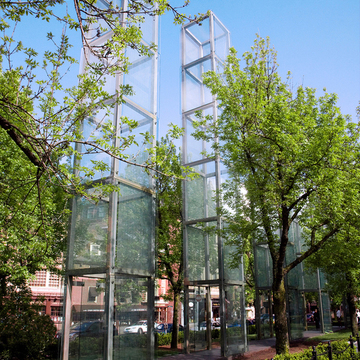On a traffic island in the heart of old Boston, the locale of dense political and economic activity, six towering glass piers, fifty-four feet high, stand as a memorial to the victims of the Holocaust. Highly charged with multifaceted symbolism, each column represents a death camp and one million Jews whose registration numbers are etched on the glass surfaces. As one walks through the granite path, metal grates reveal an underground pit, smoke evoking the burning embers of the crematoria of the death camps. At night the lit towers have been likened to a menorah of memorial candles. When one enters the memorial, one sees the Hebrew word “Remember” carved into paving stones together with the words of survivors, soldiers, and philosophers. With skyscrapers as a backdrop, the site seems completely appropriate and even contributes to the deep emotional reactions evoked—in the midst of life, a devastating reminder of death. Recipient of the American Institute of Architects' Henry Bacon Medal for Memorial Architecture in 1998, “this memorial is a statement of memory of the six million victims of the Nazi tyranny and a reaffirmation of the basic human rights of all people,” as noted in the award nomination.
At the southern section of this small park (1980, Carol Johnson Associates) stand and sit two bronze statues (by Lloyd Lillie) of Boston's Mayor James Michael Curley, an earlier monument in a much lighter vein. Perhaps the double images represent the political quip of his opponents, “Vote often and early for James Michael Curley.”


